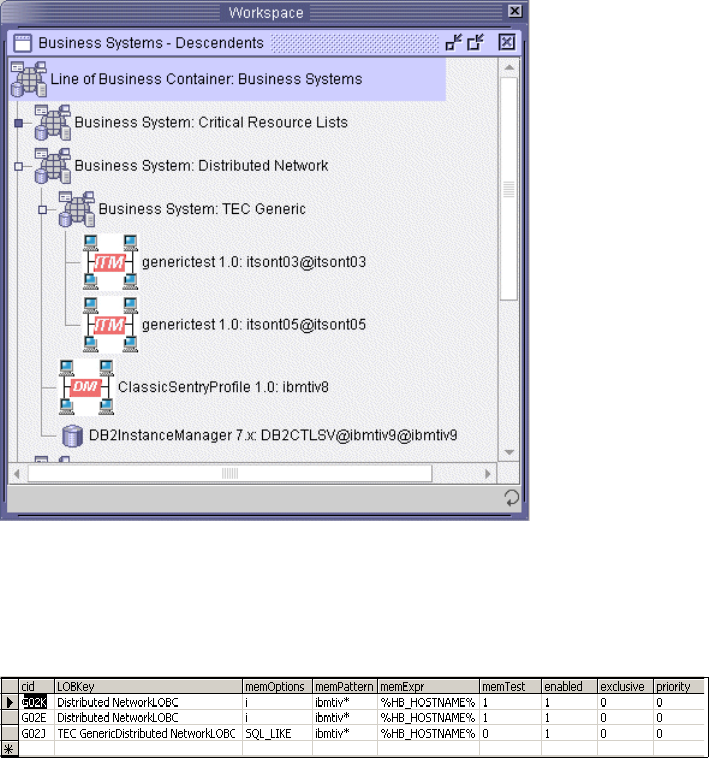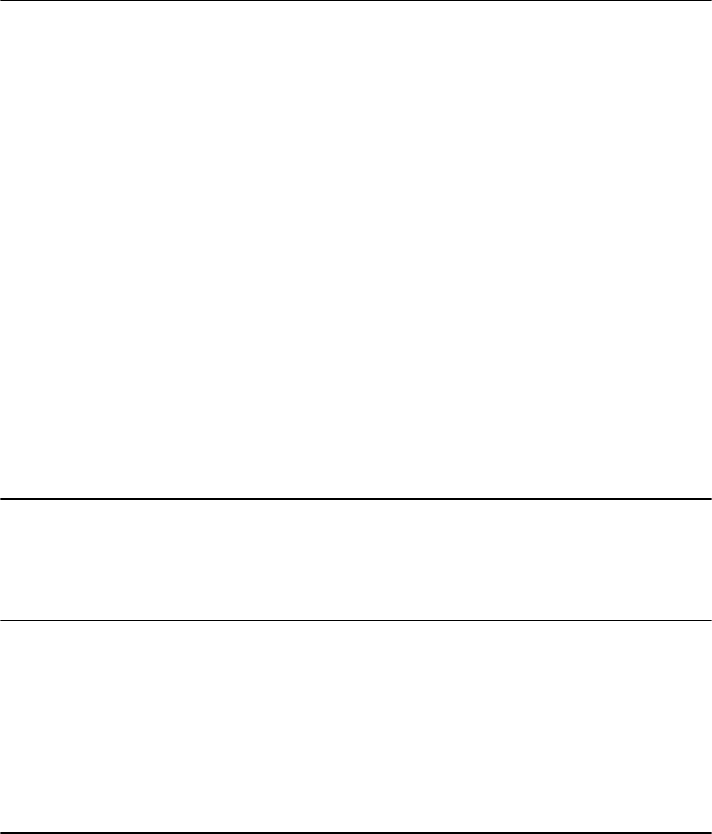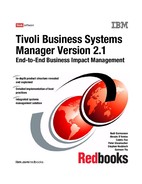414 Tivoli Business Systems Manager Version 2.1: End-to-End Business Impact Management
Path
Path Level Name
PP_0_0 1 ITSO Resources
PP_0_1 1 ITSO Resources
PP_0_0 2 Operating Systems
PP_0_0 3
PP_0_1 2 DB2 Subsystems
PP_0_1 3
CriteriaToPath
Criteria Path Level Pattern Variable Value
1001 PP_0_0 3 1 name <1:name>
1002 PP_0_1 3 2 name <2:name>
This is similar to the pattern that we hand-built except for some of the internal
names and numbers.
12.3 Distributed LOB rules to ABS migration
This section discusses the migration of the existing distributed line of business
rules to the new Automatic Business System Views process. The discussion
consists of:
? 12.3.1, “Migration description” on page 414
? 12.3.2, “Migration example” on page 415
12.3.1 Migration description
The IBM Tivoli Business Systems Manager base installation does not provide an
automatic migration from the distributed Line of Business (LOB) rules to the new
ABS process. The rules have to be migrated manually.
The commands addLOB.sh, addpvToLOB.sh and addpvToLOBInst.sh add rules into
the database that specify the Business System Views that have to be created
dynamically and the filtering criteria to use for resources that are received mainly
from TEC. These commands were available in the IBM Tivoli Business Systems
Manager version 1.5 and are still supported in Version 2.1 for backward
compatibility.
The migration process consists of extracting the existing distributed rules from
the database, rearranging them to be compatible with the new Automatic
Business System format, loading them into the database using the ABS
configuration file, and disabling the processing of the distributed rules.

Chapter 12. Automatic Business System View creation 415
12.3.2 Migration example
The Distributed Network and TEC GenericBSVs in Figure 12-11 have been
created dynamically and populated with distributed resources using the
commands addLOB.sh and addpvToLOB.sh.
Figure 12-11 Distributed Line of Business
Figure 12-12 shows the contents of the GEM_InstFiltering table. The memExpr
column lists the input we chose for filtering the events. The memPattern column
lists the regular expression pattern used by the filtering utility to match the input.
Figure 12-12 GEM_InstFiltering table
Only those instances of the G02K and G02E class that come with an host name
starting with the string “ibmtiv” are filtered and added automatically into the
Distributed Network BSV. The resources of the class G02J are added to the TEC
Generic BSV only if their host name does not contain the ibmtiv string. This last
condition is stated by the value
zero in the memTest column. The migration script

416 Tivoli Business Systems Manager Version 2.1: End-to-End Business Impact Management
cannot automatically convert certain values of the GEM_InstFiltering columns.
Table 12-1 shows the values not supported by the migration script.
Table 12-1 Distributed rules not supported by the migration script
The preceding values represent distributed rules that must be added manually
into the ABS engine.
The migration process we followed consists of these steps:
1. Convert the distributed rules to the Automatic Business System format using
the migrateToAbs.ksh script.
2. Manually add the distributed rules that are not supported to the output file
generated by the preceeding step.
3. Load the modified output file into the database with the absConfig.ksh script.
4. Disable the distributed rules, setting the enable_gem_auto_lob parameter to
no in the GEM_Options table.
The migrateToAbs.ksh command syntax is explained in detail in the
IBM Tivoli
Business Systems Manager: Administrator’s Guide
, GC32-0799. This script calls
GEM_InstFiltering column Value
memTest when = 0
memOptions
memExpr
%HB_PRIMARY%
%HB_SECONDARY%
or more then one symbol
exclusive when <> 0
priority when <> 0
Note: The GEM_InstFiltering table is preloaded with all the filtering definitions
for all the default IBM Tivoli Business Systems Manager class IDs from G000
to G02C. The migration process takes in all the data stored in that table, so the
migration output file would contain a filtering criteria for each class
represented in the table.
In our example we have deleted all the rows of the GEM_InstFiltering table
other than those representing the filtering criteria that we inserted with the
addpvToLOB.sh command. Now our output file contains just the criteria for the
classes we are interested in putting into our BSV. This selection could be also
done within the output file itself to eliminate each section’s unneeded criteria.

Chapter 12. Automatic Business System View creation 417
the gemsp_migrateToAlob stored procedure, which converts the distributed rules
and stores the data in the GEM_Pattern, GEM_CriteriaToPattern, GEM_Path,
and GEM_CriteriaToPath tables. The script also produces an output file in the
same format as the ABS configuration file.
We use the sh migrateToAbs.ksh -Sibmtiv5 -Usa -PXXXX -o migrateToAbs.txt
command to generate the migrateToAbs.txt configuration file. The output file
generated by the migration script is shown in Example 12-8.
Example 12-8 Output file migrateToAbs.txt
PatternList
ListName Operand
Pattern
Pattern Class Attribute When Operator Operand1 Operand2
1 G02E MgedSystemName Current EGREP i ibmtiv*
2 G02K MgedSystemName Current EGREP i ibmtiv*
CriteriaToPattern
Criteria Pattern PatternRelated
111
222
Path
Path Level Name
Distributed NetworkLOBC 1 Distributed Network
Distributed NetworkLOBC 2
CriteriaToPath
Criteria Path Level Pattern Variable Value
1 Distributed NetworkLOBC 2 1 name <1:name>
2 Distributed NetworkLOBC 2 2 name <2:name>
The migration tool also produces a log file containing the patterns that could not
be migrated. Example 12-9 shows the contents of the log file in our example.
Example 12-9 Log file migrateToAbs.txt.log
gemsp_migrateToAlob: @start_pattern_id=[1], @start_criteria_id=[1],
@rm_dup_patterns=[1]
Non-Migratable Patterns - do them manually !!
cid LOBKey memOptions memPattern memExpr
memTest enabled exclusive priority
---- ---------------------------------- ---------- ---------- -------------
-------- ------- --------- --------
G02J TEC GenericDistributed NetworkLOBC SQL_LIKE ibmtiv* %HB_HOSTNAME% 0
1 0 0

418 Tivoli Business Systems Manager Version 2.1: End-to-End Business Impact Management
These patterns have to be added to the output file manually. Example 12-10
shows the output file migrateToAbs.txt after editing.
Example 12-10 Output file after the manual adding of the rule not processed
PatternList
ListName Operand
Pattern
Pattern Class Attribute When Operator Operand1 Operand2
1 G02E MgedSystemName Current EGREP i ibmtiv*
2 G02K MgedSystemName Current EGREP i ibmtiv*
3 G02J MgedSystemName Current NOT LIKE ibmtiv% %
CriteriaToPattern
Criteria Pattern PatternRelated
111
222
333
Path
Path Level Name
Distributed NetworkLOBC 1 Distributed Network
Distributed NetworkLOBC 2
TEC Generic 1 Distributed Network
TEC Generic 2 TEC Generic
TEC Generic 3
CriteriaToPath
Criteria Path Level Pattern Variable Value
1 Distributed NetworkLOBC 2 1 name <1:name>
2 Distributed NetworkLOBC 2 2 name <2:name>
3 TEC Generic 3 3 name <3:name>
In case the ABS feature has already been configured, the preceeding output file
should be combined with the existing ABS configuration file. The consolidated
configuration file should then be loaded into the database. We then invoke sh
absconfig.ksh -Sibmtiv5 -Usa -Psa_ibmtiv5 -i migrateToAbs.txt to activate
the configuration.
The ABS is now configured, and its configuration data is stored in the database.
The automatic LOB for distributed rules are still active. To disable the distributed
rules the enable_gem_autolob parameter of the GEM_Options table must be set
to no as shown in Figure 12-13 on page 419.
..................Content has been hidden....................
You can't read the all page of ebook, please click here login for view all page.
